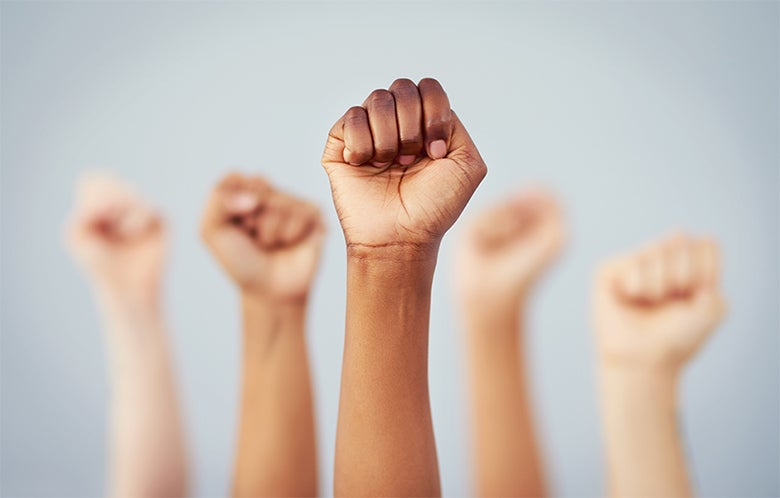Social justice is the fair and equal allocation of wealth, opportunities and privileges to people within a society — regardless of their age, gender, race, ethnicity, religion, sexual orientation, class, physical ability or mental ability.
In schools, social justice is about distributing resources equally and treating all students fairly, so that they feel safe and secure. It is also about creating learning experiences that teach students to respect diversity and confront unfair treatment. The renewed emphasis on social and emotional learning has led many schools to weave social justice education into the curriculum.
In their article “School Libraries & Social Justice,” Fitzgerald, Mignardi, Sturge and Walker illustrate how librarians have emerged as leaders in promoting social justice in schools.
“In every school across the nation, the school library is the place where all feel welcome and supported,” the authors state. “In our diverse collections, in our strides to fight fake news, in our teaching of information and social literacy, and within our interactions with students and staff, school librarians are the very defenders and champions of social justice and equity in our school communities.”
The article also describes how school librarians can leverage the AASL National Library Standards and the Teaching Tolerance Social Justice Standards in creating a culture of equity, diversity, empathy and cooperation. Strategies include highlighting social justice concepts in class readings, increasing opportunities for collaboration, and emphasizing digital citizenship.
Resources and Programming
A review of the web reveals copious resources to support school librarians in their efforts to promote social justice. Following 2017’s tragic events in Charlottesville, Virginia, School Library Journal curated a list of books, links and curriculum resources to support antibias and social justice instruction, in-service learning, programming and outreach. WeAreTeachers has also curated 21 resources for teaching about inclusion, diversity and equity. In addition to its social justice standards, Teaching Tolerance also offers a collection of classroom and professional development resources.
Here are five additional ideas librarians might consider when creating social justice experiences for their students:
1. Add more diverse books to the school library collection.
Naturally, the role of libraries in social justice education goes beyond collection development; however, increasing access to books that represent a wide range of experiences is a good place to start. Fill the library’s shelves with literature that enables students to see representations of themselves and to better understand those unlike themselves. NoveList® metadata like own voices and appeal terms like religiously diverse can help librarians provide more diverse reading recommendations. School librarians can also engage children and teens with the concepts of racism, equality and social justice by adding resources such as the EBSCO eBooks™ Antiracist Reading for Youth Collection, which offers a mix of fiction and nonfiction covering activism, the history of discrimination in the U.S. and the Black Lives Matter movement. Meanwhile, professional articles in Core Collections™ can help librarians talk with administration and parents about the importance of a diverse library collection. Don’t forget to promote the books in your collection with a social justice flyer and other tools from LibraryAware.
School librarians are the very defenders and champions of social justice and equity in our school communities.
School librarians are the very defenders and champions of social justice and equity in our school communities.
2. Collaborate with middle and high school English departments in integrating contemporary literature about diverse characters into the class reading canon.
Librarians can assist teachers in developing reading activities that ask students to analyze, interpret, critique and make connections to diverse texts — activities that will help students discover the relevance of their reading within a larger context. To support student learning and classroom instruction, EBSCO’s Poetry & Short Story Reference Center and Literary Reference Center Plus databases contain full text of contemporary works as well as biographies, articles and essays of literary criticism.
3. Start a Project LIT Community Book Club.
A literacy movement started by Nashville educator Jarred Amato and his students, Project LIT seeks to eliminate book deserts by increasing access to high-quality, culturally relevant books that spark difficult conversations and promote empathy, kindness and other 21st century skills. These books, such as “The Hate U Give” by Angie Thomas, can initiate meaningful discussions and serve as catalysts for social justice efforts. Apply to become a Project LIT Chapter Leader.
4. Host after-school film screenings.
Bring social justice topics to life by presenting and discussing films and documentaries that depict issues such as racial discrimination, gender inequality and the effects of poverty or mental illness.
5. Start a social justice service program.
High school students must often complete community service hours in order to graduate. Partner with local organizations who work to improve the lives of people who are in poverty or marginalized by society. Find out what their needs are and recruit students (and educators) to help. They can serve meals at local homeless shelters, organize food or clothing drives, visit nursing home residents, work with special needs children or participate in other activities that cultivate understanding and compassion.
